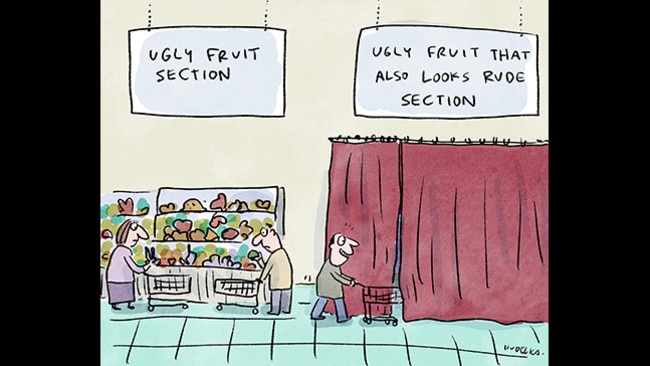Food waste kept in check with fruit and veg from the reject bins
The reject corner of the grocery store is the spot for produce that looks as if it has lived, and perhaps even partied.

I like to think of it as my weekly aid mission. I sweep into the local grocer and head straight to the rejects corner to decide what I’m going to rescue this week. Will it be a warped eggplant, twisted sweet potatoes, lumpy pink lady apples or wonky bananas? Or will their battered appearances and tragic backstories ensure I take one of each?
I usually get a few of the pears, whose scars bear testimony to a summer of storms. Can’t go past the warped eggplant that did nothing wrong except get too close to a stake early in life. And this week there’s a shipment of paw paws that obviously spent too long at a luau.
As I bundle them into green bags, I can almost hear them saying thank you — thank you for rescuing me from the ground beneath the tree, or the bin in the sorting barn or wherever slightly wonky fruit and veg go to rot.
Once we didn’t know where it went to rot. Now we do. Annual fruit and vegetable wastage is between $1000 and $2000 a household. And that’s just the stuff that gets wasted because of picky kids, poor meal planning and let’s-just-order-pizza nights. When you add in wastage along the food chain from farmer to plate, it reaches $10 billion of expensive compost.
OK, this stuff in the corner of the store is cheap. That alone would make what the French call “ugly food” attractive to people like me. But there’s more to it than that. The reject section of the grocery is a chance to express your politics on food. So, hopping on to my apple box, here’s a rant about the politics of food.
First, supermarkets say they don’t stock wonky produce because consumers won’t buy it. Did they ask you? They didn’t ask me. Obviously, back when wonky fruit still made it into fruit bins at supermarkets, people would pick the fruit and veg that looked the best. If it’s the same price, then you will choose the best, but that doesn’t mean that you won’t buy the ugly stuff for a cheaper price.
The shops could have sorted them into different bins and changed the price tags, but that would have cost them labour. It was far cheaper to say to the farmer: you do the sorting and — by the way — we won’t accept less than perfect.
While the supermarkets were imposing their look-ist policies, they added in a few other caveats. Produce, they decided, had to be easy to transport, easy to store, neat to display and varieties that could withstand lazy or rough handling in the supply chain. They wanted fruit as robust as cricket balls.
We know this as the great tomato swindle. That was the decision made by supermarkets to stock tomatoes that were evenly coloured, perfectly round and able to withstand any amount of imperfect handling, and the result was a red ball that tasted like watery mush and never seemed to ripen — perhaps in protest at being plucked too early.
It wasn’t just the taste of tomatoes we lost. The industrialisation of produce robbed us of the taste and smell and experience of fruit and veg across the range. Zombie food snuck into supermarkets overnight and no one noticed. For a while.
But enough people remembered. Or grew their own. Or stopped by roadside stalls on country trips and wondered why the fruit tasted so good. And they began to question what happened to food the modern economy rejected.
Those who remember now prowl the reject corner of the green grocer. Sure, some of those shoppers resemble hippies with hessian bags and rainbow scarfs; some have shoes down at heel and wallets light on cash. But, bloody hell, a lot of them are just shoppers with a point to make. And some even prefer the reject corner.
There’s something romantic about fruit and vegetables that bear the marks of nature. It reminds us how food grows, that it’s not stuff from a rack but something that came from the ground or the branch of a tree. This produce looks as if it has lived, and perhaps even partied.
And it might be the power of suggestion, but paw paw that’s partied too hard and pears that have knocked around trees do seem to taste better than their picture perfect cousins. You might even be tempted to pay a premium for them.



To join the conversation, please log in. Don't have an account? Register
Join the conversation, you are commenting as Logout